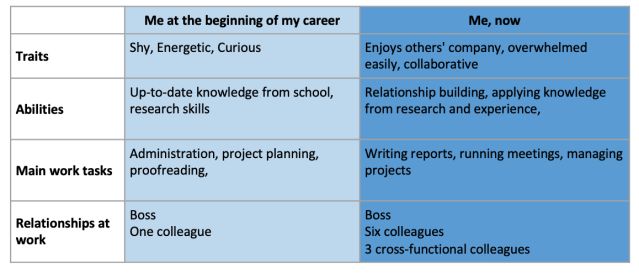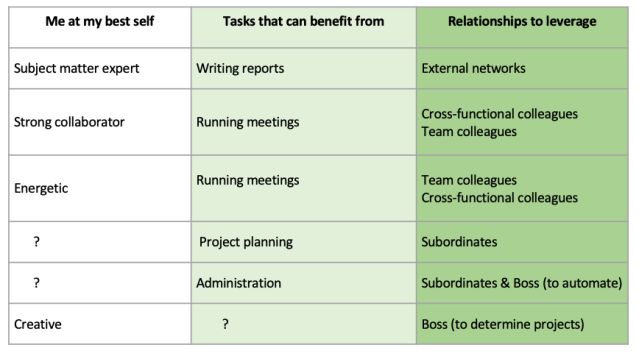Career
Getting Unstuck at Work: An Exercise
Steps for reflection and how to set goals.
Posted August 30, 2023 Reviewed by Davia Sills
Key points
- In a shifting world, evolve with purpose to drive personal and professional growth.
- Document the journey from the beginning to now, noting changes, improvements, and steps taken.
- Overcome self-imposed limits, embrace challenges, and chart a purposeful path forward.
In a world that's constantly evolving, it's essential to keep pace with your personal and professional development. Following up on my discussion of fixed mindsets and getting unstuck at work, let's delve into a practical activity that will empower you and set a transformative path for your career.
Reflection Time
First, think back to when you started your career. Think about how you described yourself then—the aspirations, skills, and capabilities that shaped your early professional journey. Recall the tasks you tackled and the support system that propelled you forward. Now, compare this self to the person you are today.

What are the differences and improvements you notice? How did you navigate these changes, and how long did they take to manifest?
Defining Your Current-Day Picture
Now that you have outlined your traits, skills, and daily work tasks, it's time to re-evaluate if they align with the person you are or who you aspire to be.
Second, write down your motivations and areas of passion—those activities that truly energize you. Also, write down your strengths—your unique skills. Then, note your core values. What principles drive you to excel?
Now, create a comprehensive table that pairs your primary tasks at work with your strengths, passions, and values.

Note when there are gaps and particularly highlight any aspects of yourself that remain untapped or underutilized.
Balancing Your Equation
Time is a limited resource, and how you allocate it shapes your well-being.
Consider any tasks not connected to your ideal sense of self. For example, with project planning, what personal traits could be most beneficial in tackling these tasks effectively? What relationships could you leverage to lessen that work? Could you delegate aspects to subordinates? Could you ask your boss for better software?
Then, take note of where your idealized self is not being fulfilled at work. For example, how can you bring creativity into your running of meetings? Is there an opportunity to update how reports are designed? Are there special projects you can ask your boss to do or join?
Plan for Your Future Self
Finally, it's time to set some goals to realign to your true self. Consider what needs to change—your approach or the task itself.
Set tangible goals about how you can address gaps today that will help you stay focused on your journey. Using the above example, the goals could be:
1. Becoming a subject matter expert
- Dedicate a focused two hours each week to staying current with the latest research and best practices.
2. Enhancing collaboration skills
- When email exchanges become unproductive, schedule a working meeting.
- Bring creativity to meetings by planning a unique approach once a month.
3. Bringing more creativity into your life
- Work with your boss during goal setting to identify one or two creative projects to work on during the year.
- Once a month, do something creative outside of work.
Harnessing a Growth Mindset
Our beliefs often shape our reality. Many people create a self-fulfilling prophecy about their skills, saying, "Oh, I'm not good at math," so they avoid math, which doesn't give them time to practice. Then, they will naturally forget it, which will ensure they have poor skills in math.
Avoid falling into the trap of self-limiting prophecies. This cycle perpetuates when we shy away from challenges, denying ourselves the chance to practice and improve. Embrace challenges as opportunities, and watch your skills flourish. Doing exercises like this helps you recognize how much you have changed over time to show that you can continue to improve.
Your career's trajectory is a journey of self-discovery, growth, and deliberate action. By aligning your passions, strengths, and values with your daily tasks, you're not just avoiding stagnation—you're cultivating a thriving and purposeful professional life. Embrace change, set intentional goals, and break free from self- or other-imposed limitations.
References
Berg, J. M., Wrzesniewski, A., Grant, A. M., Kurkoski, J., & Welle, B. (2023). Getting unstuck: The effects of growth mindsets about the self and job on happiness at work. Journal of Applied Psychology, 108(1), 152–166. https://doi.org/10.1037/apl0001021
Berg, J. M., Dutton, J. E., & Wrzesniewski, A. (2013). Job crafting and meaningful work. In B. J. Dik, Z. S. Byrne, & M. F. Steger (Eds.), Purpose and meaning in the workplace (pp. 81–104). American Psychological Association. https://doi.org/10.1037/14183-005




